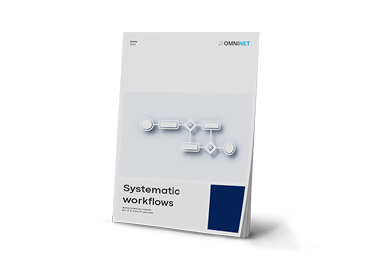EPC and BPMN 2.0 – advantages, definition, and differences of the two process modeling languages
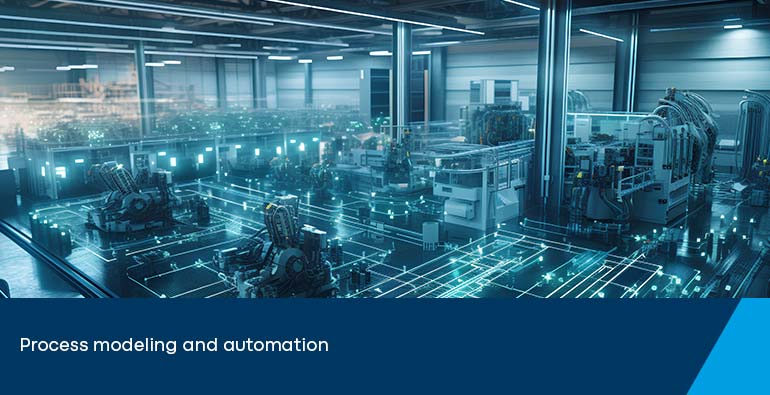
The path to better process transparency
Many things are changing, and companies are constantly confronted with new requirements, challenges, and technologies. To keep up with this increasingly fast-moving market, a company must regularly develop and improve itself and put its own processes to the test.
The modeling of all business processes is suitable for facilitating the recognition of improvement potential and the need for action within a company.
What is process modeling?
In process modeling, standardized business processes are represented graphically using a modeling language with defined syntax rules. This schematic representation of processes is used to illustrate and better understand the overall flow of the processes. Once business processes have been visualized in such a process model, they can be analyzed and optimized more easily. In addition to improving process flows, the aim is to automate the modeled processes to save additional resources and thus costs. Process modeling can therefore help to make a company’s processes more efficient, and thus also more cost-effective.
First, however, you need to decide on the process modeling language that best fits your goals and needs.
One of the most frequently used process modeling languages in Germany is the event-driven process chain (EPC). This will be presented below and compared with the Business Process Model and Notation 2.0 (BPMN 2.0), which was published later and is used worldwide.
Benefits of process modeling
- Increasing efficiency
- Increasing customer satisfaction
- Improving corporate responsiveness
- Improving corporate coordination and control
- Facilitate compliance with new regulations
- Transparency and measurability of processes
- Easier communication and collaboration
Event-driven process chain (EPC) - definition and explanation
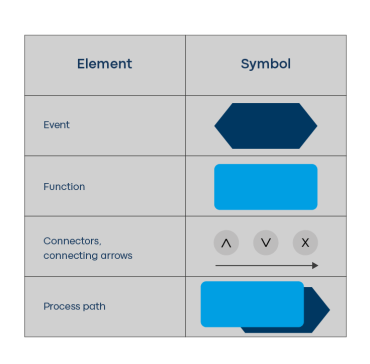
The event-driven process chain is a semiformal modeling language that graphically illustrates business processes as flowcharts with a top-down progression. It can be used to clearly represent, analyze, and optimize standard processes by easily mapping control and data flows, dependencies of events and functions, parallel processes as well as conditional branching or loops.
The basic elements of the EPC are:
- Function
Functions represent operations that are performed as a result of a triggering event.
- Event
Events represent business conditions that have occurred and that trigger an operation or are the result of an operation. - Connector (often also called operator)
Connectors logically link events and functions and are added to link arrows. They are divided into three types: an AND, an OR, and an EXCLUSIVE OR. - Connecting arrow
Connecting arrows reflect the control flow of the flowchart and can be split and reunited by connectors. - Process path
Process paths are composed of an event and a superimposed function and indicate the connection to another process or sub-process.
A process chain always begins and ends with an event or a process path. In addition, the event-driven process chain is characterized by an alternating sequence of events and functions that are linked to each other by connecting arrows and connectors.
Extended event-driven process chain (eEPC)
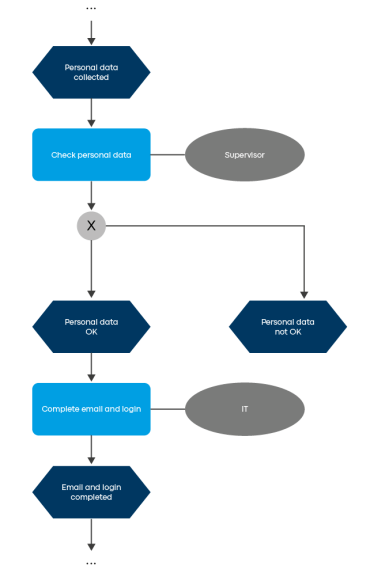
The event-driven process chain can be enhanced by two additional elements - to become the extended event-driven process chain (eEPC). These two elements are an organizational unit element and an information element, which provide a more detailed graphical representation. For example, the persons responsible for certain process steps can be mapped in this way.
Business Process Model and Notation 2.0 (BPMN 2.0) – definition and explanation
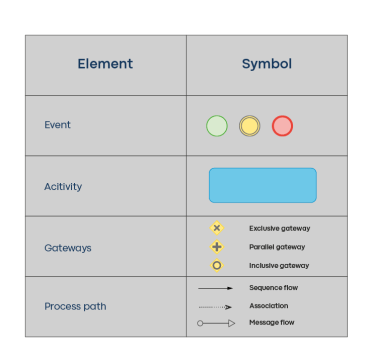
The modeling language Business Process Model and Notation 2.0, or BPMN 2.0 for short, is used for the visual representation and automation of business processes. With the internationally used notation, processes can therefore not only be represented graphically, but also executed automatically in the background. This integration of the business departments with IT sets BPMN 2.0 apart from other process model languages. BPMN can thus be seen as a cornerstone of the digital transformation, since analog processes in the company were previously mapped digitally and, based on this, controlled by IT.
The elements of BPMN 2.0 are:
- Event
Events indicate where the process or sub-process begins, where it ends, and where relevant intermediate steps are located. - Activity
Activities are concrete action steps that are connected by arrows and thus form a processing sequence. - Gateway
Gateways represent decision points in the sequence flows that trigger and merge branches. They are divided into: exclusive, parallel and inclusive gateways, among others. - Token
Tokens are used to provide a controlled and traceable flow of individual steps and indicate the current point in the execution of a process. From a technical point of view, tokens also control when an activity may be started and when it is considered finished. - Connecting arrow
Connecting arrows connect elements and may be enhanced by gateways. Depending on the nature of the lines, the arrows mean that there is a sequence flow (solid line), an association (dotted line), or a message flow (dashed line) between the connected elements. - Sub-process
Several activities can be outsourced as a sub-process to reduce the complexity of a process.
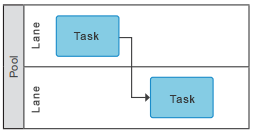 The division of the flow charts into pools (areas) with swimlanes (lanes) ensures a clear representation. A pool covers the entire process under consideration, and the swimlanes represent the responsibilities in separate lanes. The individual elements (activities, events, connecting arrows and gateways) are arranged chronologically in these lanes.With BPMN 2.0, both simple and complex processes can be visualized in a comprehensible way. In business processes that can be automated, the activities are controlled automatically via service tasks.
The division of the flow charts into pools (areas) with swimlanes (lanes) ensures a clear representation. A pool covers the entire process under consideration, and the swimlanes represent the responsibilities in separate lanes. The individual elements (activities, events, connecting arrows and gateways) are arranged chronologically in these lanes.With BPMN 2.0, both simple and complex processes can be visualized in a comprehensible way. In business processes that can be automated, the activities are controlled automatically via service tasks.
Comparison EPC vs. BPMN 2.0
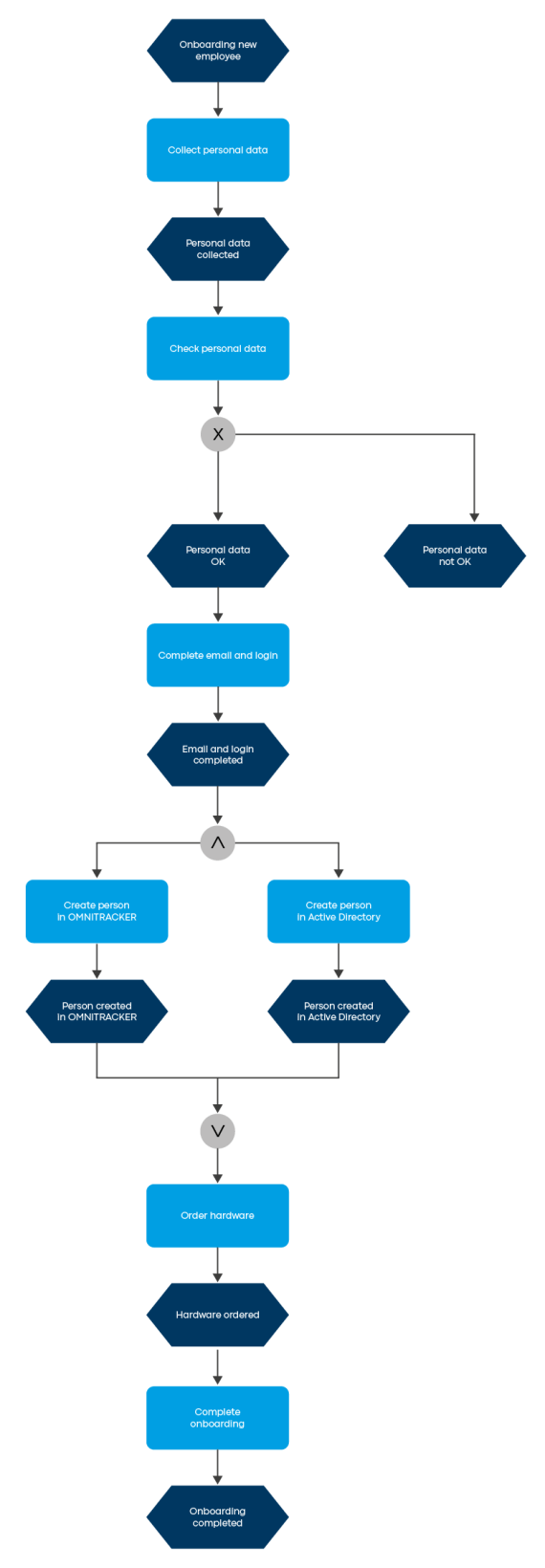
Common features
Both modeling languages can be used across applications and offer simple and clear ways of representing processes. They are easy and intuitive to use, so that even non-experts can understand and operate them well.
Differences
The two images of the same onboarding process – one as an EPC and one as a BPMN 2.0 workflow – immediately reveal the weaknesses of the EPC. The EPC requires considerably more elements to represent the process than BPMN 2.0, making it more confusing.
Representation
Regarding the representation, EPC and BPMN 2.0 differ very much. While processes are represented in the EPC from top to bottom as a diagram and responsible persons can only be entered in the extended form, the BPMN 2.0 can represent processes in pools and lanes both horizontally and vertically. On the one hand, this enables the exact mapping of responsibilities for each process step and thus ensures a much clearer arrangement than with the diagrams of the EPC (or the eEPC).
Elements
An intersection of the elements of both notations is similar, in addition, BPMN 2.0 includes a variety of other elements that give process models more accuracy and detail.
Since the EPC is event-driven, there are often duplications in process modeling that make the mapping more extensive but offer little added value – each activity (= function in the EPC) must necessarily be followed by an event and vice versa: e.g., “Reorder product” (function) -> “Product reordered” (event).
In BPMN 2.0, the token can be used to keep track of the progress of an automated process (current processing status). Tokens are also used technically to make parallel or time-controlled processes possible.
Automation
The biggest difference lies in the automation of processes, where BPMN 2.0 outshines EPC. This notation is thus better suited than the EPC for modeling non-automatable as well as automatable business processes. The BPMN engine monitors error-free process execution; employees are informed about pending tasks, external systems are activated, and automatable tasks are executed directly. This ensures that no process step is forgotten, and that the execution sequence is adhered to.
Distribution
The EPC is mainly used throughout Germany. On the one hand, this is because the notation was developed in Germany, and on the other hand, it has only been able to establish itself to a limited extent outside the German-speaking world due to its lack of standardization.
In contrast, BPMN 2.0 is used worldwide. This causes a constant further development of the tool, whereby processes can be built up more and more flexible and complex with BPMN 2.0, such as with integrated loops (repetitions), specific conditions, time control or parallel processes.
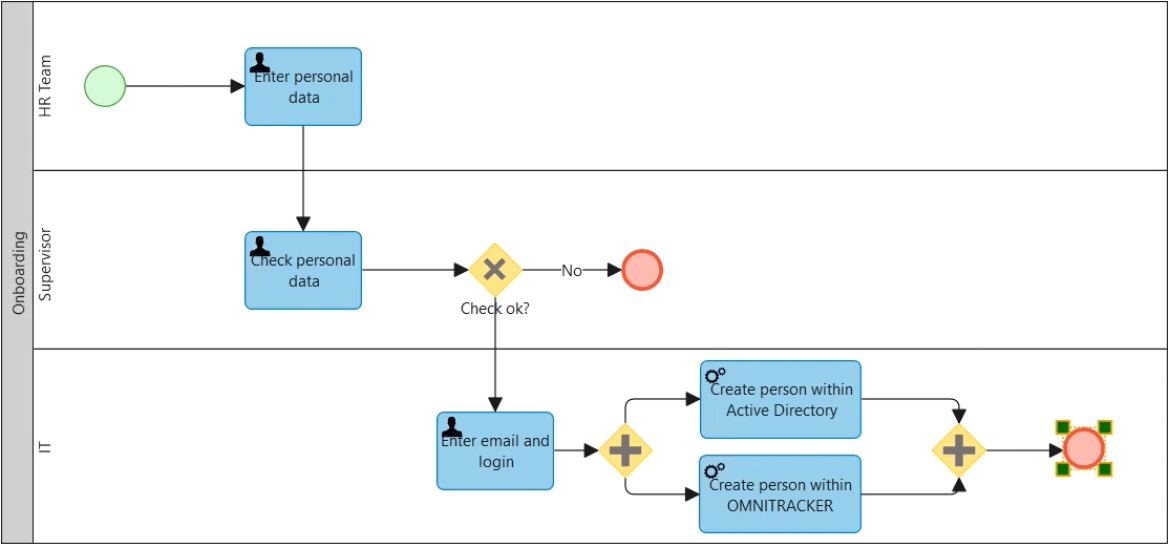
Modelling of an onboarding process with BPMN 2.0.
Our flyer Systematic Workflows shows you all the advantages of process automation with BPMN 2.0.
Conclusion: What makes BPMN 2.0 stand out
Both EPC and BPMN 2.0 are notations for process modeling that are intended to represent processes as simply as possible and as complex as necessary. Due to the manageable number of elements, they contain, they are also easy to use by non-experts.
While the event-driven process chain is particularly suitable for the representation of simpler standard processes, it is completely eclipsed by the performance-enhancing possibilities of BPMN 2.0.
With additional information elements and automation, the Business Process Model and Notation 2.0 offers options that can be used to represent both simple and more complex, automatable, and non-automatable processes.
BPMN 2.0 - Advantages at a glance
- Simplification of complex processes
- Clearer, more detailed representation
- Better understanding of processes
- Easier optimization
- Cost reduction
- International usage
You can find a comparison of BPMN 2.0 with Robotic Process Automation, a software for business process automation, in our article Robotic Process Automation (RPA) – the revolution in business process automation?
